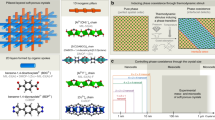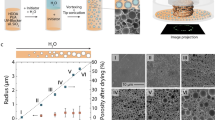Abstract
Phase separation micromolding (PSμM) is an effective technique for fabricating porous membranes with micropatterned structures. However, reports on procedures to control the size and number of open pores on the patterned surface are scarce, which often limits the use of the surface-patterned membranes. This work presents a systematic study on tailoring open pores on the patterned surface of polyethersulfone (PES) membranes prepared by the PSμM procedure. The composition of the solvent and the concentration of PES in the casting solution were optimized to tune the size and number of pores on the membrane surfaces formed on a flat substrate during the nonsolvent-induced phase separation (NIPS) process. The surface porosity changed significantly and macrovoids appeared when the flat substrate was replaced by a micropatterned substrate. The vapor-induced phase separation process was applied prior to the NIPS process to prevent the formation of macrovoids. The composition of the casting solution was tuned again to prepare micropatterned porous PES membranes with open pores on the patterned surface. We observed that the size and number of pores were different depending on the pore locations on the patterned surface, which was caused by different solvent/nonsolvent demixing dynamics resulting from the physical discontinuity of micro-patterned membranes.
This is a preview of subscription content, access via your institution
Access options
Subscribe to this journal
Receive 12 print issues and online access
$259.00 per year
only $21.58 per issue
Buy this article
- Purchase on Springer Link
- Instant access to full article PDF
Prices may be subject to local taxes which are calculated during checkout





Similar content being viewed by others
References
Jackson EA, Hillmyer MA. Nanoporous membranes derived from block copolymers: from drug delivery to water filtration. ACS Nano. 2010;4:3548–53.
Chowdhury MR, Steffes J, Huey BD, McCutcheon JR. 3D printed polyamide membranes for desalination. Science. 2018;361:682–6.
Yi S, Ghanem B, Liu Y, Pinnau I, Koros WJ. Ultraselective glassy polymer membranes with unprecedented performance for energy-efficient sour gas separation. Sci Adv. 2019;5:eaaw5459.
Xia D, Johnson LM, López GP. Anisotropic wetting surfaces with one-dimensional and directional structures: fabrication approaches, wetting properties and potential applications. Adv Mater. 2012;24:1287–302.
Choi W, Chan EP, Park J-H, Ahn W-G, Jung HW, Hong S, et al. Nanoscale pillar-enhanced tribological surfaces as antifouling membranes. ACS Appl Mater Interfaces. 2016;8:31433–41.
Peters AM, Lammertink RGH, Wessling M. Comparing flat and micro-patterned surfaces: gas permeation and tensile stress measurements. J Membr Sci. 2008;320:173–8.
Koh JK, Jeon Y, Cho YI, Kim JH, Shul Y-G. A facile preparation method of surface patterned polymer electrolyte membranes for fuel cell applications. J Mater Chem A. 2014;2:8652–9.
Vogelaar L, Barsema JN, van Rijn CJM, Nijdam W, Wessling M. Phase separation micromolding—PSμM. Adv Mater. 2003;15:1385–9.
Vogelaar L, Lammertink RGH, Barsema JN, Nijdam W, Bolhuis-Versteeg LAM, van Rijn CJM, Wessling M. Phase separation micromolding: a new generic approach for microstructuring various materials. Small. 2005;1:645–55.
Guillen GR, Pan Y, Li M, Hoek EMV. Preparation and characterization of membranes formed by nonsolvent induced phase separation: a review. Ind Eng Chem Res. 2011;50:3798–817.
Shin S-J, Kim J-P, Kim H-J, Jeon J-H, Min B-R. Preparation and characterization of polyethersulfone microfiltration membranes by a 2-methoxyethanol additive. Desalination. 2005;186:1–10.
Wu D, Zhao L, Vakharia VK, Salim W, Ho WSW. Synthesis and characterization of nanoporous polyethersulfone membrane as support for composite membrane in CO2 separation: from lab to pilot scale. J Membr Sci. 2016;510:58–71.
Ren J, Li Z, Wong F-S. Membrane structure control of BTDA-TDI/MDI (P84) co-polyimide asymmetric membranes by wet-phase inversion process. J Membr Sci. 2004;241:305–14.
Paulsen FG, Shojaie SS, Krantz WB. Effect of evaporation step on macrovoid formation in wet-cast polymeric membranes. J Membr Sci. 1994;91:265–82.
Smolders CA, Reuvers AJ, Boom RM, Wienk IM. Microstructures in phase-inversion membranes. Part 1. Formation of macrovoids. J Membr Sci. 1992;73:259–75.
ElSherbiny IMA, Khalil ASG, Ulbricht M. Surface micro-patterning as a promising platform towards novel polyamide thin-film composite membranes of superior performance. J Membr Sci. 2017;529:11–22.
Li SG, van den Boomgaard T, Smolders CA, Strathmann H. Physical gelation of amorphous polymers in a mixture of solvent and nonsolvent. Macromolecules. 1996;29:2053–9.
Lee HJ, Jung B, Kang YS, Lee H. Phase separation of polymer casting solution by nonsolvent vapor. J Membr Sci. 2004;245:103–12.
Caquineau H, Menut P, Deratani A, Dupuy C. Influence of the relative humidity on film formation by vapor induced phase separation. Polym Eng Sci. 2003;43:798–808.
Chae Park H, Po Kim Y, Yong Kim H, Soo Kang Y. Membrane formation by water vapor induced phase inversion. J Membr Sci. 1999;156:169–78.
Acknowledgements
This work is supported by the Japan Science and Technology Agency (JST) Advanced Low Carbon Technology Research and Development Program (ALCA) Grant Number JPMJAL1403.
Author information
Authors and Affiliations
Corresponding authors
Ethics declarations
Conflict of interest
The authors declare that they have no conflict of interest.
Additional information
Publisher’s note Springer Nature remains neutral with regard to jurisdictional claims in published maps and institutional affiliations.
Supplementary information
Rights and permissions
About this article
Cite this article
Liu, Y., Kodama, T., Kojima, T. et al. Fine-tuning of the surface porosity of micropatterned polyethersulfone membranes prepared by phase separation micromolding. Polym J 52, 397–403 (2020). https://doi.org/10.1038/s41428-019-0298-9
Received:
Revised:
Accepted:
Published:
Issue Date:
DOI: https://doi.org/10.1038/s41428-019-0298-9
This article is cited by
-
Poly(ether sulfone)-based ultrafiltration membranes using chitosan/ammonium chloride to enhance permeability and antifouling properties
Polymer Journal (2022)
-
The novel composite membranes containing chloride and acid functionalized multiwall carbon nanotube fillers for gas separation
Colloid and Polymer Science (2021)



